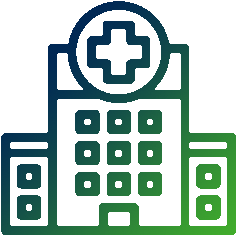Patients and health systems deserve clinicians thriving and operating at their best.
Improve Clinical Workflows
EvidenceCare's clinical decision support software is designed to create more efficient clinical workflows with a focus on empowering better care decisions and improving hospital margins.
Doctors don’t need more invasive technology.
They need the right information at the right time.
Our software is designed with our end-users in mind for improved clinical workflows.

Trusted by Top Health Systems






Clinical Workflow
The emergency department of a hospital can be a chaotic and overwhelming place. Emergency rooms attract patients who need immediate, intensive care, and every patient has different needs when they arrive.
Some people who visit the emergency room can receive treatment and remain in observation in the ED, while others need admission to the hospital and more in-depth care. Because the needs of patients in the ED vary so greatly and the course of treatment is so different for every person who comes in, it is important for a hospital to come up with smooth, reliable clinical workflows.
Perhaps you are wondering, “What is a clinical workflow?”
A clinical workflow in healthcare essentially maps out steps taken by a clinician for a patient’s route of care from the time they check in to the ED or hospital to the time they are discharged. A hospital workflow or clinical workflow definition is: a system used by emergency room and hospital teams to ensure that patients are taken care of thoroughly and consistently when they need treatment.
Clinical workflow efficiencies implemented by hospital executives and administrators determine how quickly patients can receive care. Workflows also determine how well doctors can handle their workload and how quickly patients can be handed over to an inpatient team for more treatment. Finally, effective workflows ensure that the administrative team at the hospital can gather all the information they need from patients while they are there for care.
Efficient clinical workflows mean the best results and the best experiences at a hospital for patients, doctors, and administrators alike.
What are the key workflow elements for a patient encounter?
Read on to learn more about what the clinical workflow comprises, how hospitals can improve workflows, and why the clinical workflow really matters.
Clinical Workflow Example
If you’re not sure what a good clinical workflow looks like, one of the best ways to grasp the concept is to see a clinical workflow example. Healthcare workflow examples reveal the ways that hospital teams work together well to get a patient checked in, triaged, treated, and either discharged or admitted. Organizational workflow examples can help practices or hospitals gauge whether their own workflows are effective, or whether they need to make changes in order to make patient care quicker and more efficient.
Hospitals with bottlenecks in their admissions or treatment processes in the ED can benefit from a workflow analysis.
What is workflow analysis in healthcare?
Workflow is a result not only of medical knowledge but also of systems design. A workflow analysis and interoperability analysis look at whether the system a hospital uses is the best for the organization. Workflows include many departments and individuals, and it is highly possible that there are snags in places where patients are passed between departments. With the right information, these snags can be smoothed over to create a more efficient patient care experience.
Examples of workflow analysis in healthcare include mapping out the entire process from when a patient arrives at the ED to discharge and looking for places where there are redundancies or multiple processes that happen twice.
Another workflow analysis example in healthcare is looking at the workflow in an emergency department and timing how long each process takes. While the actual medical care itself will vary based on patient needs, hospital administrators and physicians can time how long it takes for each necessary administrative task in the process to happen (checking a patient in, getting a medical history, gathering their insurance information, getting claims approved, etc.).
Timing how long each of these steps takes, noting all the people involved in each step, seeing which are taking longer than they should, and where time could be shaved off the process is a good way to ensure that the entire system is functioning as smoothly and quickly as possible.
Importance of Workflow in Healthcare
The importance of workflow in healthcare cannot be overstated. Workflow in healthcare doesn’t just impact how fast a patient gets in and out of the hospital. It can also have a major impact on the reputation of a hospital, the overall patient experience, physician and nurse retention, and the amount of revenue a hospital can generate.
Workflow issues in healthcare have been known to cause patients to choose other hospitals, reducing the amount of revenue a hospital can generate and damaging its brand reputation in the community.
Workflow issues in healthcare can also reduce physician retention, as doctors who are frustrated by administrative bottlenecks, patient overloading, and inefficient care given to patients may choose to leave a hospital or practice for one that operates more smoothly.
Workflow issues in healthcare can also cause confusion when administrative teams are collecting the information they need. Administrators need to gather information from patients so they have the necessary payment and insurance information. This allows them to verify that an insurance company will, in fact, reimburse the hospital for providing care after a patient leaves. Making sure the patient documentation is accurate before they are discharged can help avoid claim denials. With fewer claim denials, hospitals aren’t left unpaid for care they provided, and patients aren’t left with medical bills they’re unable to pay — a situation that too often results in a mountain of crippling medical debt.
Hospitals that want to thrive need to understand organizational workflow and its impact on work quality. When hospitals have the most talented doctors but cannot figure out how to efficiently get patients in and out of the right hospital bed statuses to see those doctors, the quality of care they provide doesn’t really matter. Patients and doctors alike will eventually choose to avoid the institution altogether.
Hospitals that struggle with workflow will need to do a workflow analysis, including input from nurses, doctors, and administrators. Gauging where bottlenecks happen can help hospitals address the problems at the source and come up with a better solution for how to move patients through for treatment.
One way to improve workflows at a hospital is to empower doctors and nurses with better tools. Digital software tools like clinical decision support software that are fast and reliable can reduce the amount of manual admin work physicians need to complete.
With extra time and brainpower for medical care, doctors can give more of their attention to each patient and ensure they are seen in a timely manner.
Improve Clinical Workflows
If you want to know how to improve clinical workflows in healthcare and health systems, the answer is: do not skip your workflow analysis. It is the process by which you can get to the root of an issue in your practice workflow.
These workflow analyses can take many forms and include a myriad of steps. When you find a workflow analysis process that works for you, continue to assess it at regular intervals. Staying on top of where your workflow achieves results is a good way to ensure that your hospital will continue to function well as patient needs and expectations change over time.
It’s also important to learn how to improve workflow in healthcare settings by reducing friction between the departments in a hospital and external teams involved in administration.
For example, how much time is spent going back and forth between admitting physicians, hospitalists, and utilization review teams on correct bed status? Add a peer-to-peer review, secondary level reviews, denial management with the revenue cycle and the physician advisor teams, and you’ve got 3-5 different department involved in what should be a simple clinical workflow.
EvidenceCare’s AdmissionCare software makes that entire workflow simpler by giving admitting physicians the admission criteria in the EHR at the point of care, so that the documentation is accurate, which reduces denials and the back and forth conversations about the admission decision.
Software to Improve Clinical Workflows
While there are many types of tools that can improve clinical workflows, the best are digital software tools like clinical decision support software. To improve clinical workflows, software can offer advice and insight into the best course of treatment for a particular patient so doctors can avoid time-intensive administrative work and hospitals can ensure that decisions regarding insurance and payment are made quickly and accurately.
CDS tools can aggregate data from past experiences at the hospital and integrate patient information from the EHR to offer doctors clinical decision support. This can get patients moving through a clinical workflow system as quickly as possible and ensure that doctors can provide better, more precise care faster—and that each patient gets where they need to go (hospital admission, discharge, or more time in observation) as fast as possible.
One of the best options for software to improve clinical workflows is EvidenceCare. EvidenceCare is a CDSS that was specifically designed to improve clinical workflow. The company creates products for use by doctors in the EHR or EMR. When hospitals and practices use a program like EvidenceCare to improve clinical workflows in the EHR or to optimize clinical workflows in the EMR, they can rely on solutions that are evidence-based and data-backed with the ability to customize for your health system and EHR system. These solutions ultimately empower doctors to deliver better care.
EvidenceCare clinical workflow software helps optimize multiple parts of the healthcare process. It ensures treatments are effective for patients. It ensures doctors don’t have to deal with unnecessary administrative work or unwieldy tech solutions that remove their focus from patients. It also ensures revenue cycle and utilization management teams collect all the necessary documentation to ensure patients receive care covered by their insurance, minimizing denials and effort spent collecting payment after discharge.
When you rely on a software solution like EvidenceCare and use data to make the smartest medical care decisions possible, the clinical workflow becomes easier, faster, and more streamlined. In the long run, while clinical workflow tools may mean one initial investment for your hospital or practice, everyone who touches the healthcare system will ultimately benefit.
Schedule a demo of the EvidenceCare platform today!







